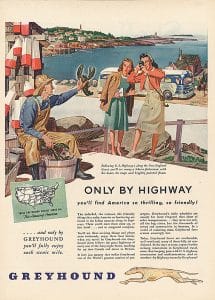From my childhood, I seem to recall an early TV advertising ditty that ended with: “Lucky us in a Greyhound bus!” Growing up in a village too small for Greyhound service, my introduction to the transportation line came from ads in magazines, newspapers, and television and from glimpses of Greyhound buses in movies, songs, and popular culture. It took me several bus rides during college and a wonderful donation to The Strong to appreciate Greyhound and its place in Americans’ fondness for travel and vacations.

The company started with just one car in 1914, transporting workers from Hibbing, Minnesota, to iron mines in nearby Alice. By the mid-1920s, Greyhound founder Carl Wickman had merged with other transport lines to serve several Midwestern states. Greyhound has grown in the century since then to serve more than 3,800 destinations across North America and to transport some 18 million passengers annually.
It has been a big player in the development of leisure travel and the vacation industry for Americans since the middle years of the 20th century. Robert Gabrick, author of Going the Greyhound Way, points out that Greyhound sold its services in the 1930s by emphasizing travel’s excitement (“Now I know how Columbus felt!”), pushing low-cost fares (“Spend less . . . and have the best vacation ever!”), and idealizing the greatness of the country it served (“Every Mile a Magnificent Mile!”). Perhaps more significantly, the image of bus travel received a big boost in the classic 1934 romantic comedy It Happened One Night, starring Clark Gable and Claudette Colbert.
One frequent passenger of “The Hound’s” system in  the 1930s grew up to assemble an impressive collection of toy Greyhound buses. Harvey Simmons figures his interest in the toys stems from his childhood travels with his family on the Greyhound line to visit distant relatives and vacation destinations. As an adult, Simmons recalled thinking of the buses as a gateway to the big, wide world beyond his hometown of Schenectady, New York. In the year that the Greyhound corporation celebrated its 100th anniversary, Simmons donated his collection of toy buses to The Strong.
the 1930s grew up to assemble an impressive collection of toy Greyhound buses. Harvey Simmons figures his interest in the toys stems from his childhood travels with his family on the Greyhound line to visit distant relatives and vacation destinations. As an adult, Simmons recalled thinking of the buses as a gateway to the big, wide world beyond his hometown of Schenectady, New York. In the year that the Greyhound corporation celebrated its 100th anniversary, Simmons donated his collection of toy buses to The Strong. 
Simmons’s generous gift to the museum includes about 200 bus models dating from the 1930s to the present day along with advertisements, brochures, a handful of pins, salt and pepper sets, post cards, and other consumer goods related to the company. The toys in the Simmons collection include buses made by major American toy companies such as Marx, Tootsietoy, Buddy L, Chein, and Mattel and by international toy companies such as Corgi, Matchbox, Cranstan, and LineMar.

Museum staff will add the Harvey Simmons Greyhound buses to The Strong’s online collections as we process this terrific collection. Check out our progress, and add a comment if you have a good Greyhound story to share. Lucky us, indeed!
 Hours 10 a.m.–5 p.m. | Fri. & Sat. till 8 p.m.
Hours 10 a.m.–5 p.m. | Fri. & Sat. till 8 p.m.